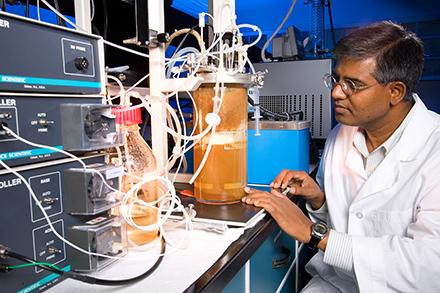ARS Looks to Find New Routes for Green Fuels and Chemicals

Nasib Qureshi, chemical engineer at the ARS Bioenergy Research Unit in Peoria, IL, observes and controls a fermenter in which butanol is produced from renewable sources like sorghum bagasse. (Photo by David Nance, D3334-1)
The United States has reduced its use of petroleum since the early 2000s by blending corn ethanol into gasoline and soy biodiesel into diesel, but annual production of those fuels has plateaued at 15 billion gallons. Now, scientists with the Agricultural Research Service (ARS) are working on ways to expand the production of biofuels – and bio-based co-products – while using less traditional food crops and more specialized new crops and feedstocks, including municipal, forest, and agricultural wastes.
Researchers at the National Center for Agricultural Utilization Research (NCAUR) in Peoria, IL, are helping to create a new industry based on the collection and conversion of agricultural crop residues and bioenergy grasses. These non-traditional feedstocks are collectively referred to as “cellulosic” biomass because they contain cellulose, the substance that stiffens the cell walls of plants.
While much harder to process than current (food) crops, cellulosic feedstocks are plentiful and have some huge advantages, according to Bruce Dien, chemical engineer at NCAUR. Eventually over 1 billion tons could be harvested each year and their bioconversion to bioproducts of all sorts could help to reduce greenhouse gas emissions.
NCAUR researchers are working on new ways to convert the biomass to biochemicals, biofuels, and other value-added products.
There are multiple routes for converting biomass to biofuels, including fermentation to manufacture corn ethanol. Corn stover (the husks, cobs, and stalks left after harvest) is milled, treated with heat (sometimes acid), and special enzymes to get out the sugars. These sugars are next fermented by microorganisms specifically selected and developed to produce products that can be used in fuels or plastics. Dien said that cellulosic biomass is more difficult to use than corn because it takes more processing and enzymes to release the sugars.
Sorghum, a traditional biofuel crop because of its high sugar content, is getting a new look from NCAUR scientists. The problem with sorghum had been what to do with the plant’s remains once the sugar has been squeezed out. In the past, these leftovers (sorghum bagasse) were either returned to the field as a soil amendment, turned into solid biofuel briquettes, or thrown away. Now, researchers have unlocked the secret of getting to the remaining sugars sequestered within these remains.
Bagasse can be pretreated to release the remaining sugars, in a process is called hydrolysis. While some biorefineries use dilute acid or alkali, Nasib Qureshi, a NCAUR chemical engineer, said that bagasse fibers can be pretreated using an environmentally friendly method – hot water. After hot water hydrolysis, a special strain of bacteria ferments the sugary liquid to create biobutanol, a superior biofuel.
Biobutanol, along with ethanol, is considered a cleaner-burning alternative to gasoline. Biobutanol can also be transported in existing gas pipelines and is less corrosive to internal combustion engines than ethanol. Biobutanol also packs 33 percent more energy per gallon than ethanol and is easier to blend with gasoline. Qureshi said biobutanol can also be catalytically upgraded to bio-jet fuel.
NCAUR researchers are looking at other uses for cellulosic sugars as well. For example, they are testing yeast that, instead of making ethanol, will produce vegetable-like oils for use in biodiesel or sustainable aviation fuel. They are also using a fungus to make an organic acid as an ingredient to make bioplastics.
“There are many reasons to invest in research to develop a cellulosic industry; however, it is a tough problem on many levels,” Dien said. “While the basic technology has been successfully developed, it still needs to be fully demonstrated at commercial scale. We are trying to enable commercialization by improving the available technologies.
“Our new research seeks to redefine the industry,” Dien said. – by Scott Elliott, ARS Office of Communications
Also in our biofuels series:

